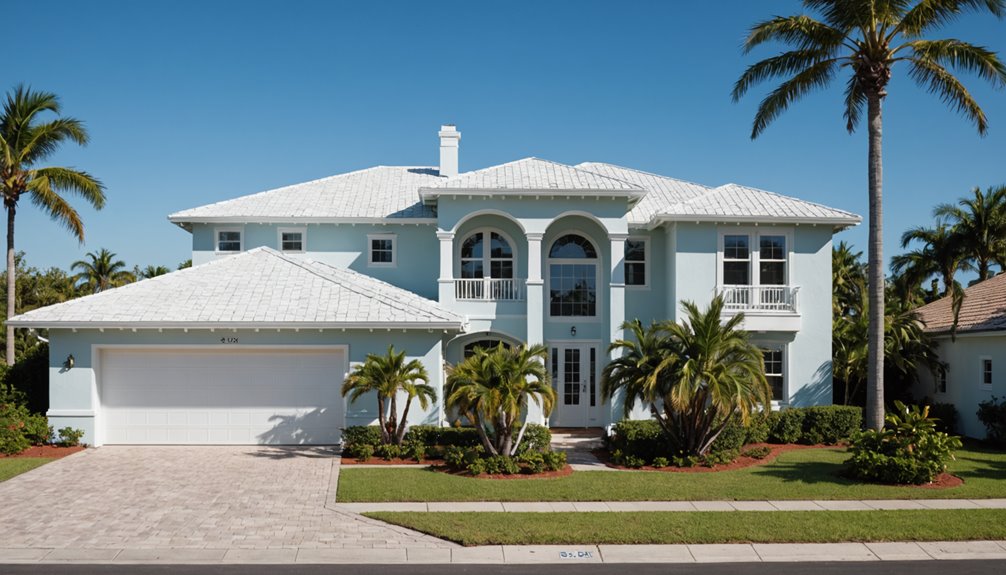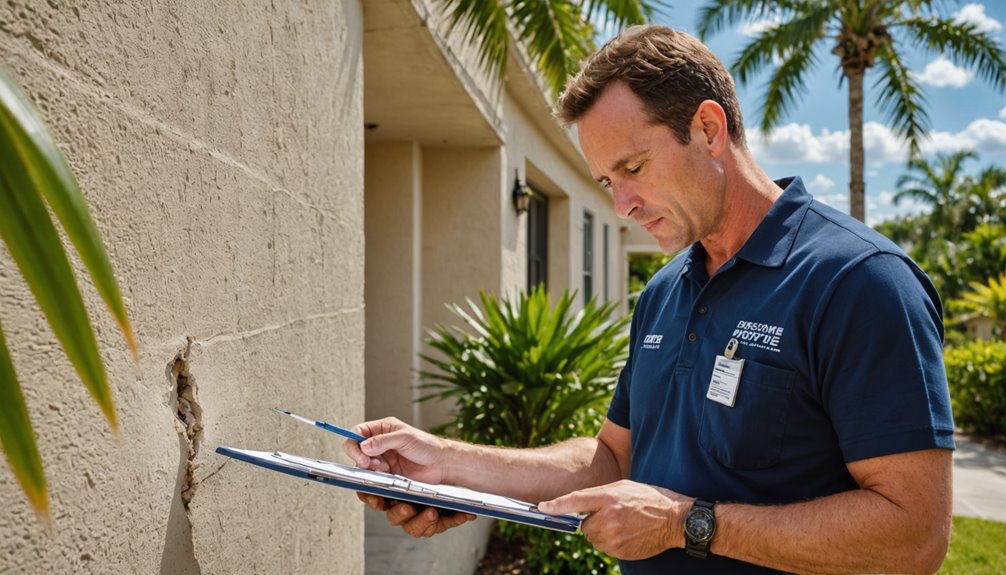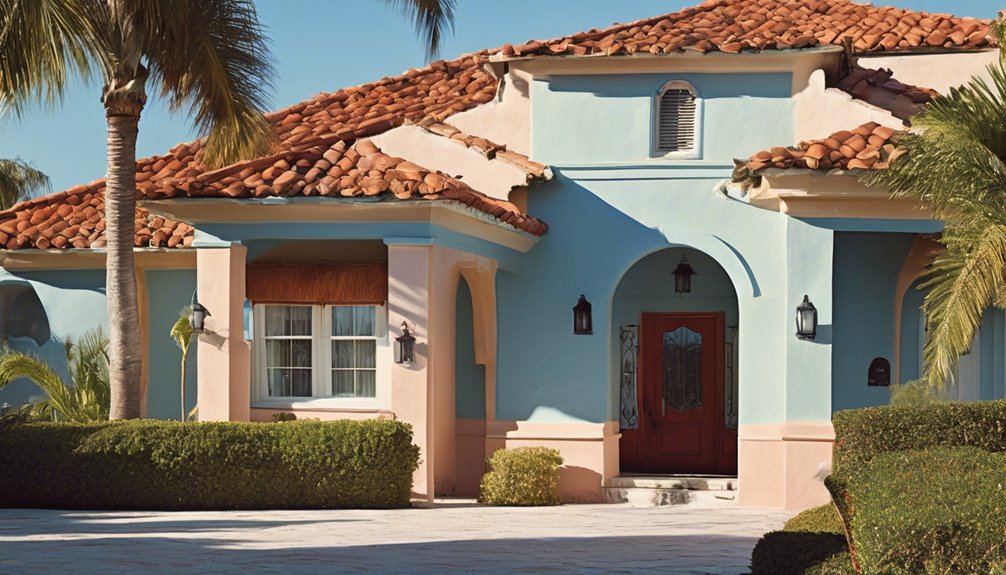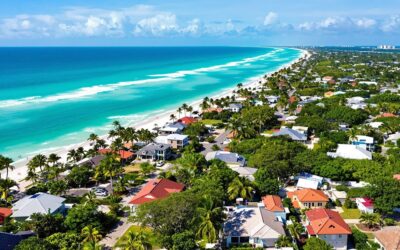Home inspections are vital in Florida due to the state’s distinctive environmental challenges. High humidity fosters mold growth, while tropical conditions increase the risks of termite and pest infestations. Nutrient pollution and hazardous waste threaten property integrity, and hurricane-prone areas demand wind mitigation assessments. Older homes require 4-point inspections for safety and insurability, while milestone inspections guarantee condo stability. These evaluations protect value and health. Exploring further reveals more profound insights into safeguarding Florida properties against a diverse range of risks.
Protecting Your Florida Home: Morgando Realty ServicesKey Takeaways
- Home inspections in Florida identify structural issues due to high humidity and hurricane risks.
- They ensure safety compliance for older homes through 4-point inspections.
- Inspections detect mold growth, prevalent in Florida’s humid, coastal climate.
- Wind mitigation reports from inspections can lower costly insurance premiums.
- They protect against termite damage, common in Florida’s tropical environment.
Understanding Florida’s Unique Environmental Challenges
While Florida is renowned for its natural beauty, the state faces significant environmental challenges that impact both ecosystems and public health. Pollution affects 24% of waterways, primarily due to the presence of harmful substances, including nitrogen, phosphorus, and bacteria. Additionally, agricultural runoff and stormwater systems exacerbate algal blooms, contributing to the decline of biodiversity. Cyanobacteria blooms, linked to neurotoxins like BMAA, are the degradation issue seen in the Lagoons. Lagoons are impacted by other degradationissues, such as the presence of hazardous waste from phosphate mining, along with over 3,000 contaminated sites, which pose risks to groundwater. Nutrient pollution has been identified as a primary cause of seagrass die-offs, which severely affect marine life, including dolphins and manatees, in critical habitats. Nutrient pollution has a significant impact.
For Floridians seeking to protect their families and properties, understanding the significance of home inspection is crucial. Inspections can reveal potential environmental hazards near homes, ensuring safer living spaces within a community committed to safeguarding its shared natural heritage.
The Importance of 4-Point Inspections for Older Homes
As homes in Florida age, the need for thorough evaluations becomes increasingly crucial to confirm safety and insurability. For properties over 25 years old, a 4-point inspection is often required, focusing on key systems, including: roof condition, electrical safety, plumbing infrastructure, and HVAC operability. These assessments, frequently required by insurers, address Florida’s harsh climate, where high humidity and frequent storms accelerate the wear and tear on systems. They serve as a critical risk assessment tool, verifying compliance with safety codes and influencing coverage eligibility. Homeowners benefit from early detection of issues, which prevents costly failures, while official reports provide documentation for insurance and future transactions.
Additionally, understanding credit requirements can further empower homeowners to make informed decisions about their properties. By joining the community of proactive owners, you can protect your investment and ensure peace of mind through these comprehensive inspections. Furthermore, these inspections are typically completed within 1 to 2 hours, providing a quick yet thorough evaluation of the property’s critical systems.
Wind Mitigation Reports and Insurance Benefits

Wind mitigation reports play a critical role in Florida’s home inspection process by documenting a property’s resistance to hurricane-force winds through detailed assessments. These reports, often based on the Uniform Mitigation Verification Inspection Form, help insurers evaluate specific features, such as roof shape and opening protections, to determine eligibility for premium discounts. By leveraging such evaluations, homeowners can achieve significant reductions in insurance costs, making these inspections a valuable tool for financial planning in areas prone to hurricanes. Additionally, understanding the importance of wind-resistant features can help homeowners make necessary upgrades to protect their property further.
Wind Report Importance
Many homeowners in Florida may not realize the critical role that wind mitigation reports play in safeguarding their properties and securing insurance benefits. These reports, conducted by licensed inspectors or certified contractors, meticulously assess structural vulnerabilities like roof deck attachments, roof-to-wall connections, and storm shutter effectiveness. They identify potential entry points for wind-driven water or debris, ensuring homes meet stringent Florida Building Code standards, particularly in High Velocity Hurricane Zones. Understanding the specific features evaluated in these reports can help homeowners maximize insurance discounts available through the Florida Wind Mitigation form.
Insurance Cost Reduction
Numerous homeowners in Florida can significantly benefit from wind mitigation reports, which can help reduce insurance costs. These reports evaluate a property’s ability to withstand hurricane-force winds, which can often lead to substantial insurance discounts. With 36% of Florida homeowners paying over $3,000 annually—double the national average—such savings are essential for affordability. Insurers may offer premium reductions when homes meet specific wind-resistant standards, aligning with state reforms that have stabilized the market and spurred rate decreases, such as the 5.6% average reduction from Citizens Property Insurance. For communities in Miami-Dade, where 75% saw rate cuts, and Broward, with 50%, these reports provide financial relief. By investing in inspections, homeowners join a collective effort to mitigate climate risks and secure cost-effective coverage in a challenging market. Additionally, with over 477,000 policies returned to the private market since 2022, homeowners can access more competitive rates through these mitigation efforts. Understanding property tax implications is also crucial for new homeowners, as it can significantly impact overall affordability.
Addressing Mold and Humidity Concerns
Florida’s subtropical climate, characterized by persistent high humidity, creates an environment where mold can thrive and pose significant risks to both property and health. This humidity, often exceeding critical thresholds, accelerates mold growth within 24-48 hours when moisture from leaks or poor ventilation is present. Understanding these conditions and their impact is crucial for conducting thorough home inspections and maintaining safe indoor environments. Regular mold inspections are essential for identifying hidden growth and preventing health issues associated with mold.
Mold Growth Risks
A pervasive challenge in Florida, mold growth poses significant risks due to the state’s unique climate conditions. With Florida scoring 38.76/40 on the FDP Mold Index—the highest in the nation—mold thrives in the typical 77°F–86°F range. Coastal areas and cities, such as Fort Lauderdale, face heightened risks from moisture retention and frequent rainfall. At the same time, older homes remain especially susceptible to infestations that can damage structures and impact human health. This high ranking on the FDP Mold Index reflects the state’s extreme humidity and rainfall, making mold prevention a top priority. Additionally, understanding hurricane preparedness can help homeowners mitigate moisture problems that lead to mold growth.
Imagine the concealed dangers in a Florida home:
- – Black mold is creeping behind walls, hidden but toxic.
- – Musty odors are lingering in poorly ventilated Tallahassee basements.
- – Wood and drywall rotting silently in Naples after coastal storms.
- – Allergies flare from spores in Gainesville’s humid summers.
Early detection through inspections is crucial for community safety.
Humidity Impact Analysis
Countless homes across Florida struggle with the pervasive challenge of humidity, a key factor that exacerbates mold growth and other structural concerns. With outdoor humidity often soaring to 75–90%, maintaining indoor levels at 45–55% RH is crucial to curb microbial risks and guarantee comfort. High moisture not only threatens health—worsening asthma and allergies through the proliferation of bacteria and VOCs—but also damages wood, electronics, and insulation, thereby weakening the home’s integrity. Energy costs rise as AC units struggle against damp air, often requiring dehumidifiers for support.. For Floridians seeking a haven, regular HVAC maintenance, strategic ventilation, and hygrometer monitoring are fundamental. Using moisture-resistant materials further protects homes, fostering a shared commitment to safeguarding spaces against Florida’s relentless humidity challenges. Additionally, understanding local assistance programs can help homeowners access resources for effectively managing humidity-related issues.
Termite and Pest Risks in a Tropical Climate
Numerous regions across Florida face heightened vulnerability to termite and pest infestations due to the state’s tropical climate, which fosters ideal conditions for rapid insect proliferation. Cities like Miami, Tampa, and Orlando rank among the nation’s worst for termite activity, driven by humidity and prolonged warm seasons that accelerate reproduction. Invasive species, such as Formosan termites, threaten infrastructure, while global trade and boat traffic worsen the spread. Homeowners bear a heavy economic burden, with Florida contributing notably to the $2 billion annual U.S. termite damage cost.
Imagine the silent destruction:
- – Subterranean termites tunneling beneath homes.
- – Wood is crumbling under Formosan termite colonies.
- – Coastal humidity is fueling insect swarms.
- – Hidden infestations devaluing cherished properties.
Proactive inspections and treatments are essential for protection. Additionally, the current housing market in Florida can exacerbate the challenges homeowners face, as rising home prices may limit options for addressing these pest issues.
Milestone Inspections for Condos and Apartments
Beyond the challenges of pest infestations in Florida’s tropical environment, property owners must also address stringent safety regulations for multi-story residential buildings. Milestone inspections, mandated for condos and co-ops three stories or taller, guarantee structural integrity under the Florida Building Code. Initial inspections are required 30 years after the Certificate of Occupancy date, with recurring checks every 10 years thereafter. Pre-2022 buildings face a deadline of December 31, 2024, for compliance. These evaluations focus on load-bearing walls, which are crucial components, and safety conditions, providing detailed reports that identify deterioration and recommend necessary repairs. Shared with associations and local officials, these findings foster community safety. For Florida’s residential communities, adhering to these standards is a crucial step in safeguarding shared spaces and ensuring peace of mind. Additionally, having a qualified agent can help buyers navigate the complexities of these inspections and ensure their investment is protected with expert market insight.
Licensing Standards for Trusted Inspectors

While milestone inspections guarantee the structural safety of multi-story buildings, the credibility of home inspections in Florida hinges on stringent licensing standards for inspectors. These requirements ensure that only qualified professionals assess properties, fostering trust within the community. Aspiring inspectors must be at least 18 years old, pass background checks, complete 120 hours of state-approved education, and pass a recognized exam, such as the NHIE. They also require $300,000 in liability insurance and must renew their licenses every two years, completing continuing education requirements.
Imagine the rigorous preparation through:
- – Hands-on training at the House of Horrors® facility.
- – Detailed courses on roofing and HVAC systems.
- – Proctored exams testing genuine-world scenarios.
- – Background checks guarantee moral integrity.
Such standards unite Floridians in confidence for reliable home inspections.
Cost Considerations and Money-Saving Tips
Maneuvering the financial aspects of home inspections in Florida requires a clear understanding of typical costs and the factors that influence them. Standard inspections typically range from $300 to $0, with prices increasing for larger homes or older properties. Urban areas, such as Jacksonville, often have higher rates ($266–$324) compared to rural zones. Tailored tests, such as termite ($75–$150) or mold assessments ($150–$350), add costs but address critical risks. Additionally, buyers should consider the implications ofhomeowners’ insurance when evaluating inspection results and potential repair costs.
To save, buyers can request ZIP-code-specific pricing, negotiate bulk rates for multiple inspections, and compare 3–5 firms. Below is a cost breakdown for clarity:
| Home Size (sq ft) | Cost Range | Tailored Test |
|---|---|---|
| <1,000 | $200–$250 | Termite: $75–$150 |
| 1,500–2,000 | $300–$400 | 4-Point: $100–$150 |
| >3,000 | $500–$1,000+ | Wind: $100–$200 |
| Older Homes | Higher Fees | Mold: $150–$350 |
| Urban vs. Rural | $266–$324+ | Bundled: Varies |
Frequently Asked Questions
How Often Should I Schedule a Home Inspection?
Regarding the frequency of home inspections, experts recommend scheduling them annually to facilitate early detection of issues and address safety concerns. For aging properties or high-risk areas, more frequent checks are recommended every 3 to 5 years.s
Can I Perform My Home Inspection?
Like traversing a labyrinth blindfolded, attempting an individualized home inspection is fraught with peril. Florida’s stringent licensing laws and complex standards require professional expertise, ensuring accuracy and legal protection for all parties involved.
What Happens if I Skip an Inspection?
Skipping an inspection can expose buyers to hidden defects, costly repairs, and legal risks. Without evidence, negotiating repairs or proving issues becomes challenging, leaving one vulnerable to financial burdens and diminished property value.
Are Inspections Required for New Constructions?
Surprisingly, over 30% of new constructions face code violations. Inspections for new builds are often mandated by local regulations, ensuring compliance and safety. Join the community of informed homeowners by prioritizing these critical assessments.
How Do I Choose a Reliable Inspector?
To choose a reliable inspector, one should verify active licensing, review client feedback, and prioritize experience with local conditions. Checking affiliations with reputable organizations, such as InterNACHI, guarantees credibility and fosters professional trust within the community.
Conclusion
In Florida, home inspections served as a shield against invisible perils, juxtaposing the state’s sunlit charm with hidden hazards such as mold and termites. They reveal truths beneath the surface—humidity’s silent creep versus structural integrity’s quiet strength. From 4-point checks to wind mitigation benefits, these evaluations protect investments, striking a balance between cost and peace of mind. For condo owners or single-family dwellers, a licensed inspector’s detailed scrutiny ensures safety, transforming tropical dreams into secure realities.
References
- https://www.realpha.com/blog/home-inspection-costs-in-florida-2024-what-you-need-to-know
- https://strangtryson.com/new-florida-condo-inspection-reserve-requirements-for-2025-what-owners-associations-need-to-know/
- https://flengineeringllc.com/building-safety-inspection-checklist-2025-2/
- https://www.homeinspectionsmiamifl.com/home-inspection-rules-in-florida-for-2025/
- https://sacinspect.com/state-by-state-home-inspector-licensing-requirements-for-2025/
- https://www.floridamuseum.ufl.edu/earth-systems/blog/floridas-environment-10-stories-to-watch-for-april/
- https://en.wikipedia.org/wiki/Environmental_issues_in_Florida
- https://www.fight4zero.org/post/florida-s-top-ten-environmental-issues
- https://www.floridahealth.gov/programs-and-services/emergency-preparedness-and-response/prepare-yourself/current-hazards/environmental-hazards/index.html
- https://www.ncei.noaa.gov/access/billions/state-summary/FL







